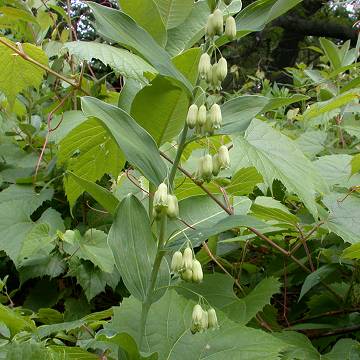

Polygonatum biflorum - (image 1 of 4)
Taxonomy
Family: Liliaceae
Gleason and Cronquist indicate that the name P. canaliculatum has been misapplied to tetraploids of this species and use the name P. commutatum for these larger, coarser plants.
Habitat
Moist woods, thickets, roadsides. In NY often found in woods on floodplains of larger rivers.
Associates
Distribution
MA and southern NH west to MN, Manitoba and ND, south to FL and northern Mexico.
Morphology
Herbaceous perennial from a jointed rhizome; stem slender or stout, 40-120(-250) cm, arching or erect; cauline bracts foliaceous, persistent; leaves sessile and often clasping, lance-elliptic to broadly oval, 5-15 cm long and 1-8 cm wide, glabrous, paler and glaucous beneath, with 7-19 prominent veins; peduncles slender or flattened, arctuate, not strongly deflexed, 1-15-flowered; pedicels usually shorter than the peduncle; flowers 14-22 mm, mostly greenish-white or yellowish-green; filaments mostly glabrous or minutely roughened.
Notes
Flowers mid May to early July
Wetland indicator: FACU
The name Solomon's Seal refers to the resemblance of the scar left when the stem is removed from the rhizome to the official seal of King Solomon. The rhizome is edible.
Polygonatum pubescens is similar but usually smaller and with leaves that are puberulent underneath.
References
Gleason, Henry A. and A. Cronquist. 1991. Manual of Vascular Plants of Northeastern United States and Adjacent Canada. Second Ed.
The New York Botanical Garden. Bronx, NY
Niering, W. A. 1979. The Audubon society field guide to North American
wildflowers: eastern region.
Knopf/Random House, New York.
Peterson, L. A. 1977. A Field Guide to Edible Wild Plants: Eastern and central
North America
Houghton Mifflin Company. New York, NY
Swink, F. and G. Wilhelm. 1994. Plants of the Chicago Region.
Indiana Academy of Science. The Morton Arboretum. Lisle, Illinois.
|
Michael Hough © 2005 |